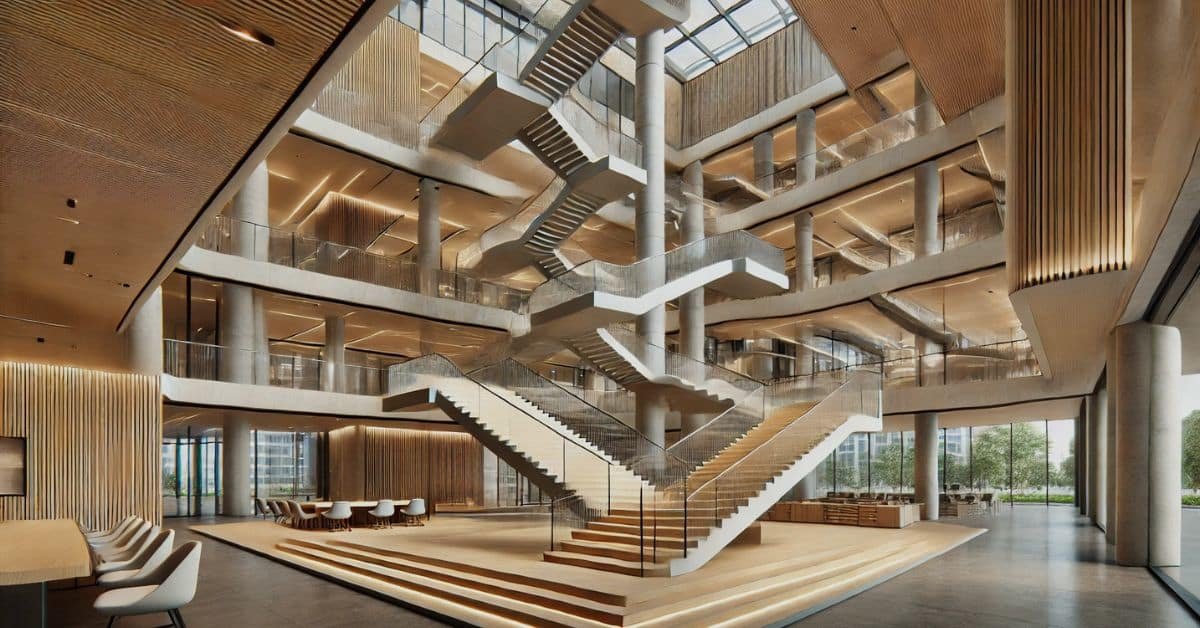Introduction: The Role of Architectural Stair Placements in Open Building Design
Architectural stair placements are more than just a functional element in a building design. They play a crucial role in the structure’s overall aesthetic, spatial organization, and flow. In open building designs, where space and openness are key features, the careful placement of stairs can transform not just how a building looks but how it feels.
Often viewed as simple connectors between different floors, stairs can become bold architectural statements when strategically designed and placed. This article explores how thoughtful Architectural Stair Placements Open Building designs can revolutionize the design and atmosphere of a space.
The Evolution of Open Building Design
Open building design refers to a flexible and adaptable approach to architecture where the building’s structure is designed with minimal interior partitions, allowing for changes in layout over time. This design trend has gained popularity in modern architecture due to its sustainability, scalability, and ability to adapt to evolving needs.
This trend has influenced the evolution of architectural stair placements in open buildings. Where traditional buildings often hide stairs in corners or behind walls, open buildings embrace them as an integral part of the design. Stairs can now be a focal point, offering unique opportunities for creativity and innovation.
Key Benefits of Architectural Stair Placements Open Building
Architectural stair placements are a critical aspect of any open building design. The following are some of the main advantages they offer:
Enhancing Visual Aesthetics
In open buildings, where every element is on display, architectural stair placements can enhance the space’s aesthetic appeal. An artistically designed staircase can act as a centrepiece, drawing attention to its craftsmanship and design. Floating stairs, spiral staircases, or minimalist stair designs can provide a dramatic impact.
Optimizing Space and Flow
Space is often at a premium in open-building designs. Clever stair placements can optimize vertical circulation while maintaining openness. By positioning stairs centrally or strategically within the building, architects can preserve the sense of spaciousness and ensure smooth circulation between floors.
Creating Visual Connections
In an open building, the design of stairs can create visual connections between different levels. Glass balustrades, open risers, or even transparent staircases help maintain sightlines, creating a continuous flow from one floor to another. This approach enhances the sense of openness and unity within the space.
Offering Flexibility and Adaptability
Open-building designs prioritize flexibility and adaptability. Architectural stair placements can support this by allowing the layout to change with minimal disruption. Using modular staircases or staircases that can be easily relocated enables the building’s interior to evolve.
Factors to Consider When Placing Stairs in Open Buildings
While the placement of stairs in an open building design is crucial, several factors must be considered to ensure that the design is both functional and aesthetic.
1. Accessibility
One of the most important considerations when placing stairs in any building is accessibility. Stairs must be placed to ensure ease of access for everyone, including individuals with mobility challenges. Elevators, ramps, or wide staircases should be considered when designing for inclusivity.
2. Safety
Safety is another primary consideration when designing stairs in open buildings. Open staircases with visible gaps between treads or glass balustrades should be designed to prevent falls. Railing height, tread depth, and other design elements must adhere to safety codes and regulations to ensure safe use.
3. Material Selection
The materials used for stairs in open building designs contribute significantly to the overall aesthetic and function. For example, wooden staircases lend warmth and organic texture to the space, while metal or glass stairs can create a sleek and modern look. Material choices also impact durability, maintenance, and cost.
4. Structural Integrity
Staircase placement must be planned with structural integrity in mind. The weight of the staircase, especially if it’s a large or complex design, needs to be adequately supported by the building’s structural framework. Coordination between architects, engineers, and contractors is essential to place the stairs securely.
Architectural Stair Placements Open Building: Transforming Design
Floating Stairs: A Symbol of Modern Design
Floating stairs are one of the most innovative stair designs in modern architecture. These stairs appear to “float” without any visible support structure, creating a sleek and minimalist aesthetic. In open buildings, floating stairs can enhance the feeling of openness while providing a unique design element.
Their placement is often central or in high-traffic areas, creating a focal point within the space. Using glass or metal for the treads and handrails further contributes to the floating staircases’ airy and contemporary feel.
Spiral Stairs: Compact and Functional
Spiral staircases offer a practical and visually appealing solution for open buildings with limited space. Their compact nature allows them to fit into tight spaces while providing easy access between floors.
Spiral stairs can be placed in corners or within alcoves, maximizing the available area without compromising the design. Their organic form adds a sculptural element to the open building, enhancing the overall aesthetic.
Modular Stairs: Customizable and Versatile
Modular staircases are an excellent choice for open buildings due to their adaptability and versatility. These stairs can be customized to fit different spaces and needs, allowing architects and designers to create unique designs tailored to specific requirements.
Modular stair systems can be easily reconfigured or relocated, making them ideal for buildings requiring design flexibility. Depending on the materials and finishes chosen, they can be designed to suit a range of aesthetics, from minimalist to industrial.
Central Staircase: A Design Statement
The central staircase is a classic design element that can dramatically impact open buildings. Positioned at the heart of the space, central staircases provide a natural flow between floors and can be designed to be a focal point of the building.
With wide, sweeping treads or an open riser design, central staircases can contribute to a space’s open and airy feeling while also providing ample room for people to circulate between levels. Their placement often encourages social interaction and movement throughout the building.
How Architectural Stair Placements Influence Building Functionality
Stair placement in open buildings affects aesthetics and the overall functionality of the space. Here’s how architectural stair placements impact the building’s usability:
Maximizing Floor Space
In open building designs, every inch of floor space matters. Thoughtful stair placements can help maximize the floor area by positioning stairs in areas that don’t interfere with functional zones. By placing stairs centrally or along one side of the building, architects can maintain open sightlines and prevent the space from feeling cramped.
Ensuring Efficient Circulation
Stair placement influences the flow of movement throughout the building. Well-placed stairs encourage easy circulation between floors, reducing congestion in common areas. Whether stairs are near entrances or central locations, efficient circulation is key to a smooth and functional design.
Supporting Multi-Use Spaces
Many open buildings are designed with multiple uses in mind—commercial, residential, or mixed-use. Flexible and adaptable architectural stair placements can support different activities by allowing easy transitions between levels without disrupting the overall flow of the space.
FAQs: Architectural Stair Placements Open Building
1. What are the benefits of architectural stair placements in open buildings?
Architectural stair placements in open buildings can enhance visual aesthetics, optimize space, create visual connections, and offer flexibility for future adaptations.
2. How do floating stairs impact the design of open buildings?
Floating stairs create a sleek and minimalist look while enhancing the feeling of openness in a building. They serve as a focal point in modern open designs.
3. What spiral stairs are best for open building designs?
Spiral stairs are ideal for open buildings with limited space. They fit compactly into tight areas and provide a functional yet stylish solution for connecting different floors.
4. Can modular stairs be reconfigured for different designs?
Yes, modular stairs are highly customizable and can be reconfigured or relocated to suit changing design needs, making them a versatile choice for open buildings.
5. How can central staircases affect the overall building layout?
Central staircases create a dramatic focal point in open buildings, ensure smooth circulation between floors, and enhance the spatial organization of the entire building.
Conclusion:
Architectural Stair Placements Open Building are more than just a means of moving between floors. They shape the building’s aesthetic, functionality, and adaptability. By thoughtfully designing stairs, architects can transform the building’s atmosphere and enhance its overall design.
Incorporating innovative stair placements, such as floating stairs, spiral staircases, modular systems, or central staircases, can elevate open building designs and ensure they remain functional, beautiful, and flexible for years to come.

Zoe Rae is a dynamic writer at SpinUpBusiness.com, where she covers a broad range of topics from business strategies to lifestyle, technology, and more. With a keen eye for detail and a passion for making complex ideas simple, Zoe crafts content that informs, engages, and inspires her readers.



